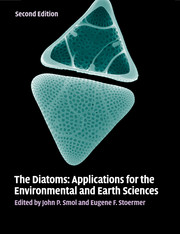Book contents
- Frontmatter
- Contents
- List of contributors
- Preface
- Part I Introduction
- 1 Applications and uses of diatoms: prologue
- 2 The diatoms: a primer
- 3 Numerical methods for the analysis of diatom assemblage data
- Part II Diatoms as indicators of environmental change in flowing waters and lakes
- Part III Diatoms as indicators in Arctic, Antarctic, and alpine lacustrine environments
- Part IV Diatoms as indicators in marine and estuarine environments
- Part V Other applications
- Part VI Conclusions
- Glossary, acronyms, and abbreviations
- Index
- References
1 - Applications and uses of diatoms: prologue
from Part I - Introduction
Published online by Cambridge University Press: 05 June 2012
- Frontmatter
- Contents
- List of contributors
- Preface
- Part I Introduction
- 1 Applications and uses of diatoms: prologue
- 2 The diatoms: a primer
- 3 Numerical methods for the analysis of diatom assemblage data
- Part II Diatoms as indicators of environmental change in flowing waters and lakes
- Part III Diatoms as indicators in Arctic, Antarctic, and alpine lacustrine environments
- Part IV Diatoms as indicators in marine and estuarine environments
- Part V Other applications
- Part VI Conclusions
- Glossary, acronyms, and abbreviations
- Index
- References
Summary
This book is about the uses of diatoms (Class Bacillariophyceae), a group of microscopic algae abundant in almost all aquatic habitats. There is no accurate count of the number of diatom species; however, estimates on the order of 104 are often given (Guillard & Kilham, 1977), although Mann & Droop (1996) point out that this number would be raised to at least 105 by application of modern species concepts. Diatoms are characterized by a number of features, but are most easily recognized by their siliceous (opaline) cell walls, composed of two valves, that, together with the girdle bands, form a frustule (Figure 1.1). The size, shape, and sculpturing of diatom cell walls are taxonomically diagnostic. Moreover, because of their siliceous composition, they are often very well preserved in fossil deposits and have a number of industrial uses.
The main focus of this book is not the biology and taxonomy of diatoms, although Julius & Theriot (this volume) provide a “primer” on this subject, and a number of chapters touch on these topics. Other books (e.g. Round et al., 1990) and the review articles and books cited in the following chapters, provide introductions to the biology, ecology, and taxonomy of diatoms. Instead, our focus is on the applications and uses of diatoms to the environmental and earth sciences. Although this book contains chapters on practical uses, such as uses of fossilized diatom remains in industry, oil exploration, and forensic applications, most of the book deals with using these indicators to decipher the effects of long-term ecological perturbations, such as climatic change, lake acidification, and eutrophication.
- Type
- Chapter
- Information
- The DiatomsApplications for the Environmental and Earth Sciences, pp. 3 - 7Publisher: Cambridge University PressPrint publication year: 2010
References
- 11
- Cited by



